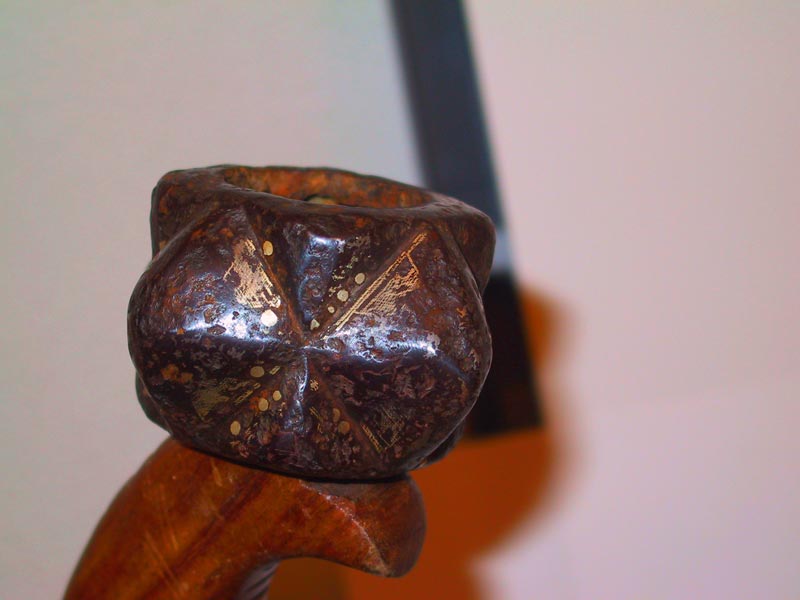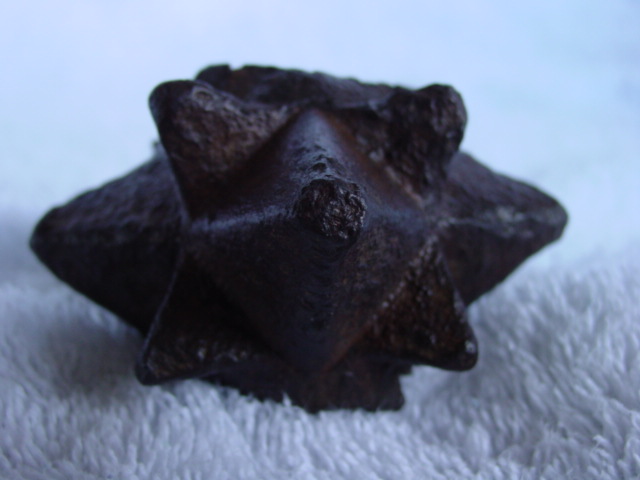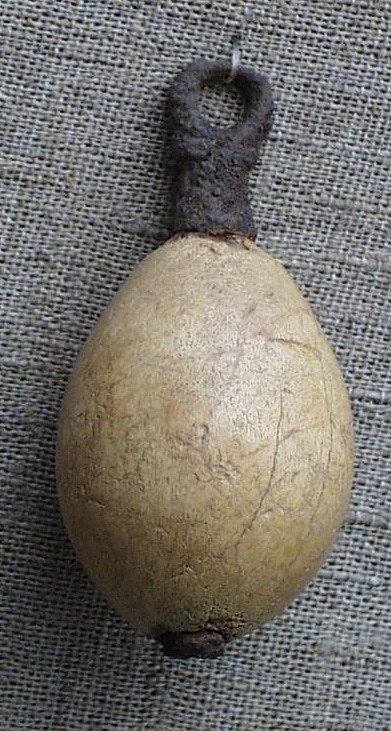
The best weapon.8-10 century or I am not right?
 Attachment: 45.43 KB
Attachment: 45.43 KB


8-10th cent; Spear and shield, backe up by Sword, Sword, Axe, dagger... Maces appeared, but come nothing near the versatility of the sword, and plain lethality against unarmoured opponents.
They are cheap, maintenance free, and relatively easy to slog around with, though.
They are cheap, maintenance free, and relatively easy to slog around with, though.
I don't think that there is a best weapon. Some are better for certain situations, but aren't particularly great in other areas. For example, sword against plate armor isn't going to go to well, whereas mace will do fine. But the sword is great for un/lightly armored opponents, where the mace is effective but not as useful.
Nice mace!
Can you supply dimensions like width, heigth and weight?
I am interested in these early facetted/geometric maces. They are commonly cast in bronze (hollow). Not sure I´ve ever seen one in iron/steel (and with inlay!)
Thanks for showing.
Can you supply dimensions like width, heigth and weight?
I am interested in these early facetted/geometric maces. They are commonly cast in bronze (hollow). Not sure I´ve ever seen one in iron/steel (and with inlay!)
Thanks for showing.
I like these maces as well. is there any evidence of this type of mace being used in migration era Scandanavia? It sounds like they were more common in southeastern europe and the near east. Are there any companies making repros? I think this should be an inexpensive way to add variety to a collection. I cant imagine the production cost would be every high, though adding inlay would get pricey for sure.
From a practical viewpoint, the "best weapon" is:
1) the one that you know how to use, and
2) the one you feel most comfortable with, and
3) the one that is the most effective against your opponent in the circumstances you are facing.
If you don't know how to use a sword, then a sword is not the best weapon for you. If you are scared of firearms, then a pistol is not the best weapon for you. If you are facing a tank, then a stone is not the best weapon for you. Thus what is the best weapon for one person in one instance may not be the best weapon for another person in another situation.
Are maces easy to use? Sure, but against a person armed with a semi-automatic pistol, a mace might not be the best weapon. Could you feel comfortable with a mace in a real fight? Perhaps, but if you aren't willing to hurt or kill your opponent with a mace, then it's just a hunk of metal on a stick. People buy guns, then leave them in their closets or drawers, never learning how to use them, never practicing with them, never getting comfortable with them. If they find themselves in an life-or-death situation, they will be more of a danger to themselves and others rather than to their opponent.
1) the one that you know how to use, and
2) the one you feel most comfortable with, and
3) the one that is the most effective against your opponent in the circumstances you are facing.
If you don't know how to use a sword, then a sword is not the best weapon for you. If you are scared of firearms, then a pistol is not the best weapon for you. If you are facing a tank, then a stone is not the best weapon for you. Thus what is the best weapon for one person in one instance may not be the best weapon for another person in another situation.
Are maces easy to use? Sure, but against a person armed with a semi-automatic pistol, a mace might not be the best weapon. Could you feel comfortable with a mace in a real fight? Perhaps, but if you aren't willing to hurt or kill your opponent with a mace, then it's just a hunk of metal on a stick. People buy guns, then leave them in their closets or drawers, never learning how to use them, never practicing with them, never getting comfortable with them. If they find themselves in an life-or-death situation, they will be more of a danger to themselves and others rather than to their opponent.
I think if maces had become the dominant weapon on the battlefield for any long amount of time, we could at least say that they were at one point a super weapon, but I'm not aware of such a period or place. Hypothetically, if they had, armor might have developed along a totally different path, thus negating their dominance. Picture an army of Michelin Men :p
I have to say that a mace, although not the best weapon is a more unexpected weapon (especially back in 9th century). Most arms used throughout history, most notably during the early medieval era, have been edged or pointy weapons meant to pierce slash and cleave through the opponent. The response to this; making armor, plate helmets, shields and maile which were effective enough against these weapons to keep them in use throughout the ages.
However against a weapon such as the mace, these pieces of armor are rendered less effective or even put the person in a disadvantageous situation. Maile will not help much against blunt force trauma, it will cushion the blow a bit, but for the most part the flexible armor will not dissipate the force enough to prevent injury. A mace blow to a helmed head will not likely kill someone but it will jar their head leaving the victim open to a second or third blow. If you strike a wooden shield with a chunk of metal on a stick it will either break the shield or send vicious shockwaves to the person's hand and arm. This may cause a less experienced warrior to drop their shield or become momentarily distracted by the sensation, either way leaving them fairly vulnerable.
Even with all of these advantages the weight concentration of a mace, the strength needed to counteract said weight and the energy you must expend to wield such a weapon means that prolonged fighting would be next to impossible. Not to mention the reach of a maces is a bit shorter then that of a sword and considerably shorter than that of a spear forcing the attacker to get up close and personal with everyone they engage. (which goes without saying is an incredibly difficult way to survive a battle)
If you are a burly fighter with abnormal stamina and a penchant for brawls, a mace is probably the best weapon you could use.
However against a weapon such as the mace, these pieces of armor are rendered less effective or even put the person in a disadvantageous situation. Maile will not help much against blunt force trauma, it will cushion the blow a bit, but for the most part the flexible armor will not dissipate the force enough to prevent injury. A mace blow to a helmed head will not likely kill someone but it will jar their head leaving the victim open to a second or third blow. If you strike a wooden shield with a chunk of metal on a stick it will either break the shield or send vicious shockwaves to the person's hand and arm. This may cause a less experienced warrior to drop their shield or become momentarily distracted by the sensation, either way leaving them fairly vulnerable.
Even with all of these advantages the weight concentration of a mace, the strength needed to counteract said weight and the energy you must expend to wield such a weapon means that prolonged fighting would be next to impossible. Not to mention the reach of a maces is a bit shorter then that of a sword and considerably shorter than that of a spear forcing the attacker to get up close and personal with everyone they engage. (which goes without saying is an incredibly difficult way to survive a battle)
If you are a burly fighter with abnormal stamina and a penchant for brawls, a mace is probably the best weapon you could use.
| C. Stackhouse wrote: |
|
Even with all of these advantages the weight concentration of a mace, the strength needed to counteract said weight and the energy you must expend to wield such a weapon means that prolonged fighting would be next to impossible. Not to mention the reach of a maces is a bit shorter then that of a sword and considerably shorter than that of a spear forcing the attacker to get up close and personal with everyone they engage. (which goes without saying is an incredibly difficult way to survive a battle) If you are a burly fighter with abnormal stamina and a penchant for brawls, a mace is probably the best weapon you could use. |
Kind of depends what sort of mace we're talking about. How about the long (3-4 ft) haft ones from Eastern Europe with a 6-10 oz. head on them. All leverage, not a lot of brute strength and stamina involved... See http://otlichnik.tripod.com/medmace0.html for more details on these sorts of mace heads. I don't have anything but anecdotal/remembered/oral information on the length of the hafts right now.
Keith N.
| Gavin Kisebach wrote: |
| I think if maces had become the dominant weapon on the battlefield for any long amount of time, we could at least say that they were at one point a super weapon, but I'm not aware of such a period or place. Hypothetically, if they had, armor might have developed along a totally different path, thus negating their dominance. Picture an army of Michelin Men :p |
I can think of a few times and places where maces were extremely important, if not dominant.
Predynastic and Early Dynastic Egypt, pre-Sargonid Mesopotamia, and ancient Iran, from the 10th century BC to the 10th century AD.
At least in Egypt, the mace kept its place as THE symbol of military power and royal authority all throughout the Dynastic period.
In Iran, the mace was also a powerful symbol as long as the Zoroastrians kept power, it being seen not least as the Weapon of Mithra.
The thing is, whether it was a "super-weapon" or not, it was never the only weapon on the battlefield. So armor had to be developed (where it did develop) that could counter other weapons as well----spears, arrows, knives/swords, axes.
Of course, in Egypt, armor was little developed until Egyptians started facing Asiatic enemies around the time of the Second Intermediate period. What armor existed was usually padded cloth, and helmets were almost unknown.
Of course, even in Europe it had its importance as symbol and weapon. What is a sceptre but a glorified, dressed-up mace?
For a strong fighter with good wind, a mace can be a very effective weapon, especially if the fighter has a shield.
It's not a good defensive weapon, but a powerful striker that can land a decisive blow.
I like 'em a lot, but I prefer spear and short-sword. :-)
:eek:
 Attachment: 95.24 KB
Attachment: 95.24 KB
[ Download ]
[ Download ]
| Keith Nelson wrote: |
|
Kind of depends what sort of mace we're talking about. How about the long (3-4 ft) haft ones from Eastern Europe with a 6-10 oz. head on them. All leverage, not a lot of brute strength and stamina involved... See http://otlichnik.tripod.com/medmace0.html for more details on these sorts of mace heads. I don't have anything but anecdotal/remembered/oral information on the length of the hafts right now. Keith N. |
You may not need much strength to wield one, but you do need some amount of strength to wield one effectively (ie. delivering lethal or debilitating blows to a human body.) Not to mention after an hour or so of fighting that 10oz head would start to feel much heavier, and with a mace that light you have to put even more force or hit more often to do the same amount of damage as a 1lb head, thus taking up more energy. Physical stamina would have been an essential part of effectively wielding a mace.
| C. Stackhouse wrote: | ||
You may not need much strength to wield one, but you do need some amount of strength to wield one effectively (ie. delivering lethal or debilitating blows to a human body.) Not to mention after an hour or so of fighting that 10oz head would start to feel much heavier, and with a mace that light you have to put even more force or hit more often to do the same amount of damage as a 1lb head, thus taking up more energy. Physical stamina would have been an essential part of effectively wielding a mace. |
Physical stamina/strenght/endurance is an integral part of every type of weapons practice.
An hour or so of constant combat (or combat-speed sparring/practice) is exhausting, with any type of weapon.
Heck, I consider 30 minutes of form work with sword or knife to be a good workout for a day. :-)
And when I speed it up with the knives, it gets tiring very quickly.
I think intensive exercise or comabt with a mace, even a light one, would be a lot like working with a heavy hammer all day long . . . :-)
| C. Stackhouse wrote: |
|
Even with all of these advantages the weight concentration of a mace, the strength needed to counteract said weight and the energy you must expend to wield such a weapon means that prolonged fighting would be next to impossible. Not to mention the reach of a maces is a bit shorter then that of a sword and considerably shorter than that of a spear forcing the attacker to get up close and personal with everyone they engage. (which goes without saying is an incredibly difficult way to survive a battle) If you are a burly fighter with abnormal stamina and a penchant for brawls, a mace is probably the best weapon you could use. |
Greetings
Please visit this site. It has some useful info on maces dimensions and weights. I think that in the great majority of examples maces are lighter than one might think except for latter medieval maces that become heavier. It is interesting to note that the mace had a strong tradition in middle eastern countries since pre history.
Hey...........I was just wondering (after reading the Mace pages) does anyone know if Stone mace heads were ever used in early Western or Eastern medieval European countries ? I realise the it would be hard to tell from period illustrations but it seems obvious that stone would be a lot more economical to produce than iron or bronze.
Hi
That mace looks 11th-12thc rus to me? Nevski period stuff, many were inlayed iron.
N
 Attachment: 58.19 KB
Attachment: 58.19 KB

That mace looks 11th-12thc rus to me? Nevski period stuff, many were inlayed iron.
N

| Merv Cannon wrote: |
| Hey...........I was just wondering (after reading the Mace pages) does anyone know if Stone mace heads were ever used in early Western or Eastern medieval European countries ? I realise the it would be hard to tell from period illustrations but it seems obvious that stone would be a lot more economical to produce than iron or bronze. |
How about bone Merv? Khazar 8th-9thc

| Merv Cannon wrote: |
| Hey...........I was just wondering (after reading the Mace pages) does anyone know if Stone mace heads were ever used in early Western or Eastern medieval European countries ? I realise the it would be hard to tell from period illustrations but it seems obvious that stone would be a lot more economical to produce than iron or bronze. |
Well, they had stoneworking tools, so you might be able to make them rather quickly, but I've a feeling the hard and inflexable head (stone being harder than metal, and more brittle) would crack too easily perhaps.
M.
Page 1 of 1
You cannot post new topics in this forumYou cannot reply to topics in this forum
You cannot edit your posts in this forum
You cannot delete your posts in this forum
You cannot vote in polls in this forum
You cannot attach files in this forum
You can download files in this forum
All contents © Copyright 2003-2006 myArmoury.com — All rights reserved
Discussion forums powered by phpBB © The phpBB Group
Switch to the Full-featured Version of the forum
Discussion forums powered by phpBB © The phpBB Group
Switch to the Full-featured Version of the forum